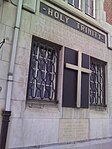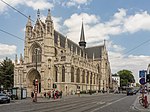The Hotel Brussels

The Hotel Brussels is a four-star hotel in the Louise/Louiza district of Brussels, Belgium, owned and managed by the Swedish hotel group Pandox AB. A landmark building, it originally opened as the Brussels Hilton in 1969. Pandox AB purchased the building in September 2010, assumed management in February 2011 and commenced a complete renovation of the 27 floors. The renovations were completed after a two-year period.The hotel is located on the Boulevard de Waterloo/Waterloolaan, between the Place Louise/Louizaplein and the Namur Gate, and next to the Egmont Palace. This area is served by the metro stations Louise/Louiza and Porte de Namur/Naamsepoort (on lines 2 and 6), as well as the tram stop Louise/Louiza (on lines 8 and 92). .
Excerpt from the Wikipedia article The Hotel Brussels (License: CC BY-SA 3.0, Authors, Images).The Hotel Brussels
Boulevard de Waterloo - Waterloolaan, City of Brussels Pentagon (Brussels)
Geographical coordinates (GPS) Address Nearby Places Show on map
Geographical coordinates (GPS)
| Latitude | Longitude |
|---|---|
| N 50.837222222222 ° | E 4.3575 ° |
Address
Boulevard de Waterloo - Waterloolaan 38
1000 City of Brussels, Pentagon (Brussels)
Belgium
Open on Google Maps









